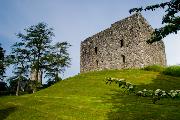Monastic Orders
Benedictines
Founded by St Benedict in 529 AD. The largest order, the Benedictines were noted for their learning. The four vows of these monks were to obedience, chastity, poverty, and manual labour for 7 hours each day. St. Dunstan, Archbishop of Canterbury from 960 AD, was responsible for establishing a large number of Benedictine houses.
England: Glastonbury Abbey, Ramsey Abbey Gatehouse, St Augustine's Abbey
Scotland: Dunfermline Abbey, Iona Abbey, Kilwinning Abbey
Carthusians
The Carthusians lived lives of isolation and silence, spending their days in their own individual cells. The monks wore hair shirts and saw each other only on Sundays and feast days, but even then conversation was rarely allowed. The main Carthusian monastery in Britain was at Charterhouse in London. After the Dissolution of the Monasteries, this became Charterhouse School. The Carthusians were too strict an order to win wide appeal.
To Visit: Mount Grace Priory
Cistercians
Begun in France under the influence of St.Bernard of Clairvaux, the order chose isolated rural locations to build their monasteries, particularly in Wales and in the north, where they reclaimed land laid waste by William the Conqueror. They were not so scholarly as the Benedictines but focussed on agriculture and hard manual labour.
One unanticipated result of this work ethic was that several monasteries, such as Fountains (Yorkshire), became very rich, and owned large parcels of land. Their architecture is renown for its elegant Gothic simplicity.
England: Cleeve Abbey, Fountains Abbey, Hailes Abbey, Rievaulx Abbey
Scotland: Culross Abbey, Deer Abbey, Dundrennan Abbey, Glenluce Abbey, Melrose Abbey, Sweetheart Abbey
Wales: Abbey Cwymhir, Cymer Abbey, Strata Florida, Tintern Abbey
Augustinians
Founded in the 11th century, these "Black Canons" lived in communities but went out among the populace to preach. As a consequence of this, and their propensity for giving alms and hospitality, the Augustinians were quite popular, and their churches were thus large and ornate.
England: Cartmel Priory Gatehouse, Lanercost Priory, Penmon Priory, Thornton Abbey
Scotland: Cambuskenneth Abbey, Inchmahome Priory, Jedburgh Abbey
Cluniacs
The Cluniacs were one of several orders who tried to return the Benedictine rule to its original simplicity. They first came to England at Lewes in about 1078. The Cluniacs spent much of their time in devotion, and left the agricultural toil to paid servants. Most Cluniac establishments were small; the largest were at Much Wenlock, Castle Acre, and Thetford.
To Visit: Crossraguel Abbey (Scotland)
Premonstratensians
Also known as the "White Canons", founded their first house in England at Newsham (1143). They were known for their austere, strict rule.
England: Bayham Abbey, Shap Abbey
Scotland: Dryburgh Abbey
Trinitarians
Also called Mathurins or "Red Friars" - originally founded in 1197 to rescue Christian captives, they also spent large amounts of their money on alms for the poor. Their major house was at Knaresborough (North Yorkshire).
Military Orders
Knights of the Temple (Templars)
Founded in Jerusalem in 1118 for the expressed purpose of protecting (Christian) travellers to the Holy Land. The Templars became the "bankers of Christendom", and owned huge amounts of property throughout Europe.
The order came to England under King Stephen, and the Temple Church in London is a good example of their habit of building round churches or at least incorporating rounded shapes into their architecture. The order was officially disbanded in the early 14th century, though its legacy lives on in the many place names incorporating the word "temple".
England: Temple Church (London), Little Maplestead (Essex).
Knights of St. John of Jerusalem
Also known as the Knights Hospitallers, originally provided hospitality and medical care to pilgrims in the Holy Land. The Hospitallers came to England under Henry I. They founded houses where novices could be trained in military arts and receive religious instruction. When the Templars were disbanded the Hospitallers received many of their churches and other property.
Related:
Medieval Monastic Life
The Medieval Church
Abbeys and Monasteries in England
Abbeys and Priories in Scotland
Abbeys in Wales

